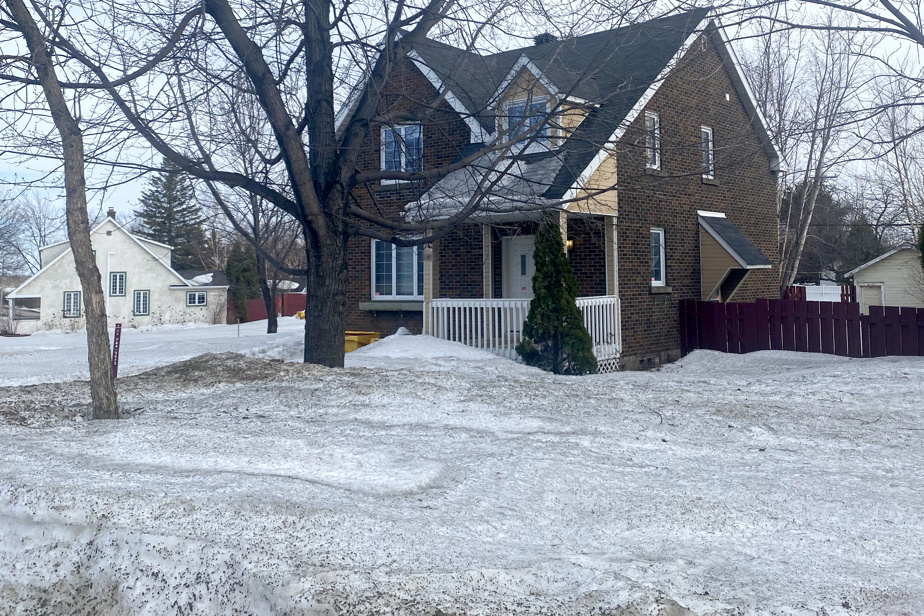The Ministry of the Environment has opened a criminal investigation into the Horne smelter in Rouyn-Noranda, in addition to imposing a fine, in connection with strong winds which carried copper concentrate and mining residues into the environment and in the Notre-Dame district, close to the factory belonging to the multinational Glencore.
On March 7, strong winds hit Rouyn-Noranda, carrying copper concentrate stored outside at the Horne Foundry site in the neighboring Notre-Dame district as well as on Lake Osisko, which borders the city to the north. -East.
On the same day, mine tailings stored in the Horne 5 tailings pond were also released into the environment as well as onto Lake Pelletier, southwest of the municipality.
Wind-blown tailings were visible where they were deposited, obscuring the snow and ice on both lakes.
After these strong winds, it took a week for Glencore to start collecting snow, as required by the Ministry of the Environment, the Fight against Climate Change, Wildlife and Parks (MELCCFP). The company says it became aware of the “wind washout” of copper concentrate stored on its site only on March 9, “while citizens made reports”.
“We went on site to see the incident and the areas affected, writes the superintendent of communications and relations with the community of Glencore, Cindy Caouette. Afterwards, we worked to set up pick-up teams, which takes some time and explains why the pick-up did not start until March 15th. »
This is what the Ministry accuses Glencore of under section 21 of the Environment Quality Act, which states that “anyone who is responsible for an accidental release […] shall, without delay , notify the Minister”. He must also “stop the release” and “remove the contaminated material from the affected area and ship it to an authorized place”.
“The law is very clear, the entire discharge must be recovered, argues the regional director of environmental control at the MELCCFP, Annie Cassista. We monitored the work on the ground on a daily basis. Certainly choices have been made. The areas that were recovered first are public areas, parks, the Osisko peninsula. »
The event convinced the MELCCFP to open a criminal investigation, which could lead to the submission of the entire file to the Director of Criminal and Penal Prosecutions (DPCP), who would then decide what to do next.
“They are the ones who will establish what will be the statements of offense related to the file. Then, if there is no guilty plea, the file can move to court, where it will be up to the judge to set the amount of the fines according to the types of offense,” says Annie Cassista, specifying that it would be up to a judge to set the fine in connection with these offenses, the law providing for a range that can vary from $6,000 to $6 million.
Following the Horne 5 tailings site event, the MELCCFP also says that it sent a notice of non-compliance last Friday accompanied by a monetary administrative penalty of $10,000 to Glencore in connection with the rejection of these mine tailings in the environment.
For the Ministry, the file is far from closed, even if the snow has practically disappeared in Rouyn-Noranda, which will likely complicate the clean-up operation.
“With the snow melting, we continue to do our monitoring. For us, the work is not over, it must continue. It is certain that the method of intervention must change, ”continues Ms. Cassista.
The MELCCFP says it must discuss with the company to determine with it how to proceed to recover all the discharges emitted into the environment. “Currently, we have demanded the complete removal of tailings and concentrates,” she reiterates. And there, we follow up on this breach with an administrative monetary penalty [for the tailings site] and an investigation [criminal for the copper concentrate]. »
However, snow removal delays have made it impossible to venture onto Lake Osisko safely. The copper concentrate will therefore probably end up in the waters of the lake, already contaminated by heavy metals – aluminum, copper, cadmium and lead, according to a study carried out in 2015 – in connection with the activities of the foundry since 1927, but also by discharge of municipal sewage.
“The snow picking operation continued until it was impossible to pick it up due to the hot temperatures of the past few days which [have] accelerated the melting. Only the snow on the ground surrounding Lake Osisko [was] picked up, because after a risk analysis it appeared that it was too dangerous to go on the lake with machinery to carry out snow picking, “writes Cindy Caouette, adding that “sediment barriers have been installed”.
The Territory Collective, which aims to revitalize Lake Osisko in preparation for the city’s 100th anniversary in 2026, had set up community fishing cabins on the lake during the winter. More than a hundred children were expected to engage in ice fishing activities in a school setting during the month of March. Despite the absence of clear directives from Public Health in this regard, the Collective has seen fit to cancel the holding of these activities.
Asked about this, Public Health said on Tuesday that it was “reassured since the dirty snow has been removed from public places” and directed us to the Ministry of the Environment. Despite numerous reminders insisting on the fact that all of the copper concentrate and mining residues had not been recovered, it was not possible to obtain further information, in particular on the behavior to adopt in the event of exposure and possible health effects.
Asked about a possible criminal prosecution, the Horne Foundry said it had not “received any information” in this regard and preferred not to comment further.

